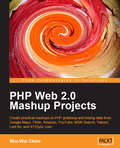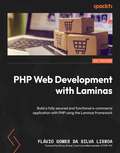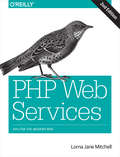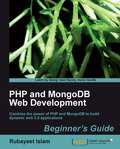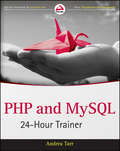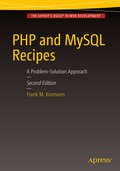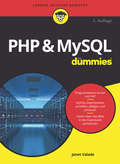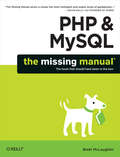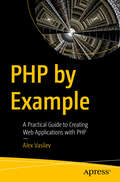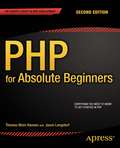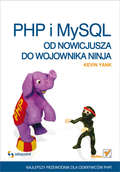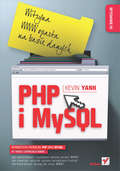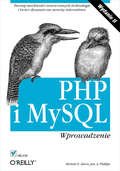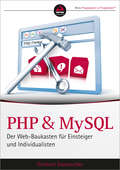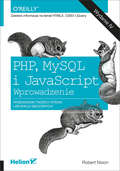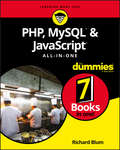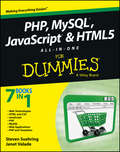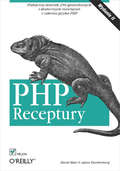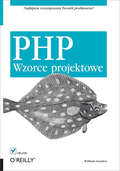- Table View
- List View
PHP Web 2.0 Mashup Projects
by Shu-Wai ChowThis book is a practical tutorial with five detailed and carefully explained case studies to build new and effective mashup applications. If you feel confident with your PHP programming, familiar with the basics of HTML and CSS, unafraid of XML, and interested in mashing things up, this is the book for you! There are a lot of formats and protocols, web services and web APIs encountered in this book â " you do not need to know anything about them or about AJAX; you will find all you need in the book.
PHP Web Development with Laminas: Build a fully secured and functional e-commerce application with PHP using the Laminas framework
by Flavio Gomes Lisboa Enrico ZimuelLearn how to develop modern object-oriented applications with PHP using test-driven development (TDD) and behavior-driven development (BDD) aided by mature reusable componentsKey FeaturesCreate clean code based on components' reusability to create large-scale enterprise applicationsMake effective use of design patterns in an object-oriented softwareUnderstand the division of a PHP web application structure in layers to build customized websites and apps for various business needsBook DescriptionConsidered the next generation of the Zend framework, Laminas is a high-performance PHP framework for creating powerful web applications with an evolutive architecture.This book takes a hands-on approach to equip you with the knowledge of the Laminas framework necessary to start building web applications based on the reuse of loosely coupled components. You'll learn how to create the basic structure of a PHP web application divided into layers, understand Laminas' MVC components, and be able to take advantage of the Eclipse platform as a method for developing with Laminas. Step by step, you'll build an e-commerce application based on the technical requirements of a fictional business, and get to grips with implementing those requirements using Laminas components.By the end of this web development book, you'll be able to build a completely secured MVC application in PHP language using Laminas.What you will learnDiscover how object-relational mapping is implemented with laminas-dbUnderstand behavior-driven development concepts to sharpen your skillsCreate lean controllers and flexible viewsBuild complete models and reusable componentsExplore the Eclipse platform for developing with LaminasFind out how easy it is to generate HTML forms with laminas-formPractice test-driven development to write precise programsWho this book is forThis book is best suited for programming beginner or developers with some experience looking to create clean-coded object-oriented web applications. Knowledge of basic PHP syntax, specifically variables, control structures, and functions, will aid you in understanding the concepts covered.
PHP Web Services: APIs for the Modern Web
by Lorna Jane MitchellWhether you’re sharing data between two internal systems or building an API so that users can access their data, this practical guide has everything you need to build APIs with PHP. Author Lorna Jane Mitchell provides lots of hands-on code samples, real-world examples, and advice based on her extensive experience to guide you through the process—from the underlying theory to methods for making your service robust.You’ll learn how to use this language to work with JSON, XML, and other web service technologies. This updated second edition includes new tools and features that reflect PHP updates and changes on the Web.Explore HTTP, from the request/response cycle to its verbs, headers, and cookiesWork with and publish webhooks—user-defined HTTP callbacksDetermine whether JSON or XML is the best data format for your applicationGet advice for working with RPC, SOAP, and RESTful servicesUse several tools and techniques for debugging HTTP web servicesChoose the service that works best for your application, and learn how to make it robustDocument your API—and learn how to design it to handle errors
PHP and MongoDB Web Development Beginner’s Guide
by Rubayeet IslamThe book follows a "Code first, explain later" approach, using practical examples in PHP to demonstrate unique features of MongoDB. This book is packed with step-by-step instructions and practical examples, along with challenges to test and improve your knowledge. This book assumes that you are experienced in web application development using PHP, HTML, and CSS. Having working knowledge of using a relational database system such as MySQL will help you grasp some of the concepts quicker, but it is not strictly mandatory. No prior knowledge of MongoDB is required.
PHP and MySQL 24-Hour Trainer
by Andrea TarrStep-by-step lessons for using PHP and MySQL in a unique book-and-video combination Assuming no previous experience with PHP or MySQL, this book-and-video package is ideal reading for anyone who wants to go beyond HTML/CSS in order to provide clients with the most dynamic web sites possible. The approachable tone breaks down the basics of programming and PHP and MySQL in individual lessons starting with the installation of the programs necessary to run PHP. You begin with a static web site and then watch and learn as PHP functionality is added as you work through the lessons.When working with databases, the MySQL database is introduced with demonstrations that show how to interact with it. The accompanying videos enhance your learning experience, as each lesson in the book is portrayed in the video exercises.Lessons include:??Getting started with PHP ??Setting up your workspace??Adding PHP to a web page??Learning PHP syntax? ??Working with variables ??Debugging code? ??Working with complex data ??Making decisions ??Repeating program steps ??Learning about scope??Reusing code with functions??Creating forms??Introducing object-oriented programming??Defining classes??Using classes??Using advanced techniques??Handling errors??Writing secure code??Introducing databases ??Introducing MySQL??Creating and connecting to the ??Creating tables ??Entering data ??Selecting data ??Using multiple tables ??Changing data ??Deleting data ??Preventing database security issues ??Creating user logins ??Turn the case study into a content management systemNote: As part of the print version of this title, video lessons are included on DVD. For e-book versions, video lessons can be accessed at wrox.com using a link provided in the interior of the e-book.
PHP and MySQL Recipes
by Frank M. KromannThis book is a source of instant solutions, including countless pieces of useful code that you can copy and paste into your own applications, giving you answers fast and saving you hours of coding time. You can also use this book as a reference to the most important aspects of the latest PHP scripting language, including the vital functions you know and love from previous versions of PHP, as well as the functions introduced in PHP 7. PHP and MySQL Recipes: A Problem-Solution Approach supplies you with complete code for all of the common coding problems you are likely to face when using PHP and MySQL together in your day-to-day web application development. This invaluable guide includes over 200 recipes and covers numerous topics. What you hold in your hands is the answer to all your PHP 7 needs. Furthermore, this book explains the PHP functionality in detail, including the vastly improved object-oriented capabilities and the new MySQL database extension. PHP and MySQL Recipes will be a useful and welcome companion throughout your career as a web developer, keeping you on the cutting edge of PHP development, ahead of the competition, and giving you all the answers you need, when you need them. What you'll learn How to work with arrays, dates and times, strings, files and directories, and dynamic imaging How to write regular expressions in PHP How to use the variables and functions found in PHP How to do web development using PHP, including the creation of forms How to use MySQL databases using phpMyAdmin and other tools and clients How to use MySQL stored routines, PDOs, triggers, views, database queries, transactions, indexes and searching Who this book is for This reference is for experienced PHP and MySQL programmers and web developers who have at least some PHP and MySQL programming experience.
PHP and MySQL for Dynamic Web Sites: Visual Quickpro Guide
by Larry UllmanIt hasn't taken Web developers long to discover that when it comes to creating dynamic, database-driven Web sites, MySQL and PHP provide a winning open-source combination. Add this book to the mix, and there's no limit to the powerful, interactive Web sites that developers can create. <p><p>With step-by-step instructions, complete scripts, and expert tips to guide readers, veteran author and database designer Larry Ullman gets right down to business: After grounding readers with separate discussions of first the scripting language (PHP) and then the database program (MySQL), he goes on to cover security, sessions and cookies, and using additional Web tools, with several sections devoted to creating sample applications. <p><p>This guide is indispensable for beginning to intermediate level Web designers who want to replace their static sites with something dynamic. In this edition, the bulk of the new material covers the latest features and techniques with PHP and MySQL. Also new to this edition are chapters introducing jQuery and object-oriented programming techniques.
PHP and MySQL für Dummies (Für Dummies)
by Janet ValadePHP ist nach wie vor die wichtigste serverseitige Websprache und MySQL das wichtigste Webdatenbank-Managementsystem. Als Team sind die beiden unschlagbar, wenn es um die Erstellung dynamischer Webseiten geht. In diesem Buch erklärt Ihnen Janet Valade die Grundlagen und das Zusammenspiel von PHP und MySQL anhand typischer Anwendungsbeispiele.
PHP and MySQL: The Missing Manual
by Brett Mclaughlin<p>If you can build websites with CSS and JavaScript, this book takes you to the next level—creating dynamic, database-driven websites with PHP and MySQL. Learn how to build a database, manage your content, and interact with users through queries and web forms. With step-by-step tutorials, real-world examples, and jargon-free explanations, you’ll soon discover the power of server-side programming.</p>
PHP and script.aculo.us Web 2.0 Application Interfaces
by Sridhar RaoThis book has a fast-paced and practical approach. It focuses on features, tutorials, quick-explanations, tips-n-tricks, and live real-world examples, using script.aculo.us. It contains complete code for all projects, all in an AJAX way. The author uses his vast experience as a programmer to show an interesting and creative way of building web applications. This book is for web developers who build simple yet agile and useful web applications. It is useful for PHP beginners and assumes basic knowledge of HTML, CSS, JavaScript, and PHP. The examples in the book use PHP, but can be adapted easily to other languages.
PHP by Example: A Practical Guide to Creating Web Applications with PHP
by Alex VasilevLearn to create web applications in PHP with minimal previous experience. This book is a practical guide to using PHP for web development. Loaded with examples and step-by-step instructions, each chapter is dedicated to a specific area or function. You’ll first review the main principles of PHP and what is needed to program and develop in it. You’ll then study variables, data types, control statements, arrays, and functions, all critical for creating efficient PHP programs. The book then moves on to object-oriented programming (OOP) and how to implement those principles in PHP, as well as inheritance, interfaces, testing, error handling, and exceptions. By the end of PHP by Example, you will have the knowledge and confidence to implement PHP for your web projects both large and small. What You’ll Learn Understand PHP from the ground up Create scripts and implement them in real-world projects Work with a broad toolkit of ready-made exercises and solutions Investigate the main constructions of the PHP
PHP for Absolute Beginners
by Thomas Blom Hansen Jason LengstorfPHP is a server-side scripting language that enables you to develop dynamic sites that engage users in ways that are simply not possible using only HTML and CSS. PHP for Absolute Beginners takes a practical approach to teaching you how to build dynamic content for your website using PHP. You'll quickly get started with practical PHP projects, learning how to build a dynamic image gallery. By the end of the book you'll will have developed a personal blog complete with a password protected admin module. PHP for Absolute Beginners won't swamp you with every detail of the full PHP language up front - instead, you'll be introduced to a small, versatile subset of PHP and learn to use it creatively to develop dynamic web sites. In the process you will learn to use variables, control structures, functions, and objects to your advantage. You will learn how to plan and create databases and how to organize your PHP scripts beautifully. At the end of the book, you will be a confident PHP user, ready to take the next steps in creating great websites.
PHP i MySQL. Od nowicjusza do wojownika ninja
by Kevin YankNajlepszy przewodnik dla odkrywców PHP!J?zyk PHP wci?? zyskuje na popularno?ci. Kolejne wersje, ci?g?e ulepszenia sprawiaj?, ?e w niektórych obszarach zaczyna on rywalizowa? z weteranami na rynku j?zyków programowania. Ten trend wida? równie? w ofertach pracy. Programi?ci biegle znaj?cy PHP s? wr?cz rozchwytywani na rynku! Warto do??czy? do tego grona. Je?li chcesz tworzy? zaawansowane aplikacje i pozna? PHP na wylot, trafi?e? na wymarzon? ksi??k?!Dzi?ki niej ju? wkrótce staniesz si? prawdziwym ninj? programowania w PHP. Przeprowadzi Ci? ona przez wszystkie etapy poznawania j?zyka: skonfigurujesz serwer WWW i MySQL oraz PHP. Nast?pnie zaprojektujesz swoj? pierwsz? baz? i pod??czysz si? do niej, ?eby zapisa? i pobra? dane. W kolejnych rozdzia?ach przekonasz si?, jak wyra?enia regularne mog? Ci pomóc w codziennej pracy, dlaczego nale?y korzysta? z sesji oraz co mo?esz zapisa? w „ciasteczkach”. „PHP i MySQL. Od nowicjusza do wojownika ninja” jest genialnym przewodnikiem po PHP i MySQL. Pozwoli Ci przeobrazi? si? z laika w profesjonalist?. Zainwestuj w t? wiedz?!B?yskawicznie opanuj:konfiguracj? serwera WWW i bazy danych MySQLpobieranie danych z bazy i zapisywanie ich do bazysposoby wykorzystania sesji i plików cookiesniuanse j?zyka PHPZainwestuj w now? wiedz? o j?zyku PHP!
PHP i MySQL. Witryna WWW oparta na bazie danych. Wydanie IV
by Kevin YankWykorzystaj potencja? PHP oraz MySQL w Twoich serwisach WWW! Jak zainstalowa? i uruchomi? w?asny serwer WWW?Jak stworzy? autorski system zarzšdzania tre?ciš?Jak kontrolowa? dost?p do stron WWW?PHP i MySQL to najpopularniejszy tandem webmasterski. Ilo?? serwisów opartych na tym po?šczeniu jest nie do ogarni?cia. Skšd taka popularno??? Niezale?nie od innych zalet atutem tego rozwišzania jest prostota. Ju? kilka chwil wystarczy, ?eby rozpoczš? przygod? z profesjonalnym tworzeniem serwisów WWW. A je?eli po?wi?cisz troch? wi?cej czasu, poznasz i wykorzystasz jeszcze wi?cej mo?liwo?ci PHP i MySQL. Ale czy rzeczy proste nie mogš by? jeszcze prostsze?Mogš. Z ksiš?kš "PHP i MySQL. Witryna WWW oparta na bazie danych. Wydanie IV" b?yskawicznie przebrniesz przez proces instalacji wszystkich niezb?dnych komponentów — niezale?nie od systemu, którego u?ywasz. Autor opisuje tu sposób instalacji na platformach Windows, MacOS X oraz Linux. Po udanej instalacji napiszesz swój pierwszy skrypt, a nast?pnie przejdziesz do kolejnych, coraz bardziej zaawansowanych tematów. W?ród nich znajdziesz opisy takich zagadnie?, jak: j?zyk SQL, sk?adnia PHP, nawišzywanie po?šczenia z bazš, publikowanie tre?ci znajdujšcych si? w bazie. Ponadto zdob?dziesz wiedz? z zakresu administrowania bazš MySQL, systemów zarzšdzania tre?ciš, zarzšdzania sesjš czy te? wykorzystania wyra?e? regularnych. Ksiš?ka ta jest nieocenionš pomocš dla wszystkich osób zaczynajšcych przygod? ze stronami WWW oraz j?zykami PHP i SQL.Instalacja systemu na platformach Windows, Linux oraz MacOS XMySQL — podstawowe zagadnieniaPHP — sk?adnia, podstawowe polecenia i strukturyNawišzywanie po?šczenia z bazš danych z poziomu PHPPublikacja tre?ci zawartych w bazie MySQLZasady projektowania relacyjnej bazy danychTworzenie systemu zarzšdzania tre?cišWykorzystanie wyra?e? regularnychKontrola dost?pu do stronZarzšdzanie sesjš oraz "ciasteczkami"Zadania administracyjne w bazie MySQLTworzenie zaawansowanych zapyta? MySQLPrzechowywanie i wykorzystanie danych binarnych Twórz dynamiczne, bogate w tre?ci i ?atwe w zarzšdzaniu witryny WWW!
PHP i MySQL. Wprowadzenie. Wydanie II
by Michele E. Davis Jon A. PhillipsPoznaj mo?liwo?ci nowoczesnych technologii i twórz dynamiczne serwisy internetowe Jak sprawdzi? poprawno?? danych i obs?ugiwa? b??dy?Jak zapisywa? nazwy u?ytkowników i has?a w bazie danych?Jak tworzy? zapytania do bazy danych za pomoc? funkcji PHP?PHP i MySQL to ju? standardowe technologie do tworzenia dynamicznych stron internetowych wykorzystuj?cych bazy danych. Istotne jest, ?e zapewniaj? one nie tylko interaktywno??, ale równie? wysoki stopie? bezpiecze?stwa witryn WWW. Ich ogromne mo?liwo?ci powoduj?, ?e wykorzystywane s? do tworzenia zarówno prostych aplikacji, jak i skomplikowanych stron internetowych, zaopatrzonych w rozbudowane systemy autoryzacji, na przyk?ad ró?nego rodzaju sklepy internetowe. Po??czenie PHP i MySQL stanowi wi?c niezast?pione narz?dzie do tworzenia dynamicznych witryn, spe?niaj?cych wymagania zarówno administratorów, jak i u?ytkowników.Ksi??ka "PHP i MySQL. Wprowadzenie. Wydanie II" przedstawia krok po kroku zasady tworzenia serwisów WWW z wykorzystaniem baz danych. W podr?czniku na przyk?adach przedstawiono m.in. sposoby pracy z baz? danych MySQL, serwerem WWW Apache czy j?zykiem PHP i XHTML. Czytaj?c t? ksi??k?, nauczysz si? przeprowadza? operacje na danych, zarz?dza? sesjami i tabelami oraz tworzy? zapytania. "Learning PHP &My SQL" stanowi niezb?dny podr?cznik zarówno dla pocz?tkuj?cych Czytelników, jak i programistów, którzy mieli wcze?niej do czynienia z j?zykiem HTML, a teraz chc? tworzy? dynamiczne i bezpieczne strony internetowe.Tre?? generowana dynamicznie i InternetPodejmowanie decyzji w PHPFunkcje i tablicePobieranie danych z kilku tabelPraca z baz? danych MySQLOperatory logiczneWspó?praca PHP i MySQLFormularze siecioweXHTMLPliki cookie, sesje i kontrola dost?puModyfikowanie obiektów MySQL i danych PHPOto ca?a, aktualna wiedza, której potrzebujesz, aby tworzy? interaktywne strony WWW.
PHP in Action: Objects, Design, Agility
by Chris Shiflett Marcus Baker Dagfinn ReiersolTo keep programming productive and enjoyable, state-of-the-art practices andprinciples are essential. Object-oriented programming and design help managecomplexity by keeping components cleanly separated. Unit testing helps preventendless, exhausting debugging sessions. Refactoring keeps code supple andreadable. PHP offers all this-and more.PHP in Action shows you how to apply PHP techniques and principles to all themost common challenges of web programming, including:Web presentation and templatesUser interaction including the Model-View-Contoller architectureInput validation and form handlingDatabase connection and querying and abstractionObject persistence Purchase of the print book comes with an offer of a free PDF, ePub, and Kindle eBook from Manning. Also available is all code from the book.
PHP in a Nutshell: A Desktop Quick Reference
by Paul HudsonNow installed on more than 20 million Internet domains around the world, PHP is an undisputed leader in web programming languages. Database connectivity, powerful extensions, and rich object-orientation are all reasons for its popularity, but nearly everyone would agree that, above all, PHP is one of the easiest languages to learn and use for developing dynamic web applications. The ease of development and simplicity of PHP, combined with a large community and expansive repository of open source PHP libraries, make it a favorite of web designers and developers worldwide.PHP in a Nutshell is a complete reference to the core of the language as well as the most popular PHP extensions. This book doesn't try to compete with or replace the widely available online documentation. Instead, it is designed to provide depth and breadth that can't be found elsewhere. PHP in a Nutshell provides the maximum information density on PHP, without all the fluff and extras that get in the way. The topic grouping, tips, and examples in this book complement the online guide and make this an essential reference for every PHP programmer. This book focuses on the functions commonly used by a majority of developers, so you can look up the information you need quickly. Topics include:Object-oriented PHPNetworkingString manipulationWorking with filesDatabase interactionXMLMultimedia creationMathematicsWhether you're just getting started or have years of experience in PHP development, PHP in a Nutshell is a valuable addition to your desk library.
PHP jQuery Cookbook
by Vijay JoshiWritten in Packt's cookbook style, this book presents numerous practical examples that you can use directly in your applications. The book covers most of the essential issues you will face while developing your web applications and gives solutions to them. Recipes in the book are written in a manner that will rapidly take you from a beginner to expert level.If you want to use PHP and jQuery together to create web applications this book is for you. It provides a large number of examples in each chapter that will take you from a basic developer to a pro by giving step-by-step instructions for each task in developing web applications using PHP and jQUery. All you need are JavaScript basics and you are on your way to building power web applications, with this book in hand.
PHP und MySQL: Der Web-Baukasten für Einsteiger und Individualisten
by Giesbert DamaschkeSie haben schon eigene Webseiten gebaut und möchten diese nun mit Funktionen ausstatten, für die Sie PHP und MySQL benötigen? Giesbert Damaschke zeigt Ihnen in diesem Buch, wie Sie das schaffen. Schritt für Schritt erlernen Sie die benötigten Programmier- und Datenbankgrundlagen - immer im Rahmen von typischen dynamischen Anwendungen. So erheben und speichern Sie zum Beispiel mit Formularen Kontaktdaten, prüfen Benutzereingaben, erstellen Menüs, richten einen Besucherzähler ein, verschicken E-Mails mit PHP oder entwickeln sogar einen eigenen Blog. Alle Codebeispiele werden ausführlich erklärt, sodass Sie sich schnell zurechtfinden werden, wenn Sie ein wenig HTML und CSS beherrschen. Programmier- oder Datenbankkenntnisse werden nicht vorausgesetzt. Jedes Kapitel bietet Ihnen Übungsaufgaben, an denen Sie Ihr neu gewonnenes PHP- und MySQL-Wissen praktisch testen können. Die lauffähigen Musterlösungen können Sie zusammen mit den Beispieldateien herunterladen, um sich daran zu orientieren oder auch gleich in Ihre Website einzubauen. So gelingt Ihnen der Einstieg in PHP und MySQL mit Sicherheit!
PHP, MySQL i JavaScript. Wprowadzenie. Wydanie IV
by Robert NixonPrzewodnik twórcy stron i aplikacji sieciowych!PHP wraz z baz? danych MySQL oraz j?zykiem JavaScript to pot??ne trio, dzi?ki któremu mo?esz zbudowa? aplikacj? internetow? dowolnej wielko?ci. Je?eli do tego do?o?ysz mo?liwo?ci najnowszej wersji j?zyka HTML (oznaczonej cyfr? 5), CSS3 oraz bibliotek? jQuery, nic nie b?dzie w stanie zatrzyma? Twojej kreatywno?ci.Je?eli chcesz opanowa? te narz?dzia i stworzy? atrakcyjn? oraz funkcjonaln? aplikacj? internetow?, trafi?e? na idealn? ksi??k?. Znajdziesz tu niezb?dn? wiedz? o j?zyku PHP, bazie danych MySQL, HTML5, CSS3, JavaScripcie i jQuery. Ju? od pierwszych stron zaczniesz poznawa? sk?adni? oraz konstrukcje j?zyka programowania PHP, techniki programowania obiektowego oraz praktyczne porady zwi?zane z u?ywaniem PHP. Nast?pnie uzupe?nisz wiedz? na temat bazy danych MySQL. Dowiesz si?, jak tworzy? zapytania SQL oraz w jaki sposób wykorzysta? dane zawarte w bazie z poziomu PHP. Po opanowaniu „strony serwerowej” przejdziesz do nauki technik tworzenia interaktywnych stron WWW. Zobaczysz, jak u?ywa? j?zyka JavaScript, jakie nowo?ci zawiera HTML5 oraz jak wielki potencja? kryj? w sobie CSS3 i jQuery. Ksi??ka ta jest ciekaw? lektur? dla pasjonatów chc?cych tworzy? w?asne, zaawansowane aplikacje. Dog??bnie opanuj j?zyk PHP, pocz?wszy od podstaw a? do metod programowania obiektowego. Zapoznaj si? z MySQL, od struktury bazy danych do skomplikowanych zapyta?. Naucz si? u?ywa? rozszerzenia MySQLi — udoskonalonego interfejsu PHP dla MySQL. Twórz dynamiczne strony PHP, które dostosowuj? si? do u?ytkownika. Zarz?dzaj ciasteczkami i sesjami, z zachowaniem wysokich standardów bezpiecze?stwa. Opanuj j?zyk JavaScript i wzboga? go z u?yciem jQuery. Wykorzystaj ??dania Ajax do komunikacji mi?dzy przegl?dark? a serwerem. U?yj CSS2 i CSS3 do opracowania profesjonalnej szaty graficznej stron WWW. Poznaj nowe funkcje HTML5, w tym geolokacj?, obs?ug? d?wi?ku i filmów oraz elementu canvas.Kompendium wiedzy dla twórcy stron i aplikacji sieciowych
PHP, MySQL, & JavaScript All-In-One For Dummies
by Richard BlumLearn the essentials of creating web apps with some of the most popular programming languages PHP, MySQL, & JavaScript All-in-One For Dummies bundles the essentials of coding in some of the most in-demand web development languages. You'll learn to create your own data-driven web applications and interactive web content. The three powerful languages covered in this book form the backbone of top online apps like Wikipedia and Etsy. Paired with the basics of HTML and CSS—also covered in this All-in-One Dummies guide—you can make dynamic websites with a variety of elements. This book makes it easy to get started. You'll also find coverage of advanced skills, as well as resources you'll appreciate when you're ready to level up. Get beginner-friendly instructions and clear explanations of how to program websites in common languages Understand the basics of object-oriented programming, interacting with databases, and connecting front- and back-end code Learn how to work according to popular DevOps principles, including containers and microservices Troubleshoot problems in your code and avoid common web development mistakes This All-in-One is a great value for new programmers looking to pick up web development skills, as well as those with more experience who want to expand to building web apps.
PHP, MySQL, & JavaScript All-in-One For Dummies
by Richard BlumExplore the engine that drives the internet It takes a powerful suite of technologies to drive the most-visited websites in the world. PHP, mySQL, JavaScript, and other web-building languages serve as the foundation for application development and programming projects at all levels of the web. Dig into this all-in-one book to get a grasp on these in-demand skills, and figure out how to apply them to become a professional web builder. You’ll get valuable information from seven handy books covering the pieces of web programming, HTML5 & CSS3, JavaScript, PHP, MySQL, creating object-oriented programs, and using PHP frameworks. Helps you grasp the technologies that power web applications Covers PHP version 7.2 Includes coverage of the latest updates in web development Perfect for developers to use to solve problems This book is ideal for the inexperienced programmer interested in adding these skills to their toolbox. New coders who've made it through an online course or boot camp will also find great value in how this book builds on what you already know.
PHP, MySQL, JavaScript & HTML5 All-in-One For Dummies
by Steve Suehring Janet ValadeGet the basics on four key web programming tools in one great book! PHP, JavaScript, and HTML5 are essential programming languages for creating dynamic websites that work with the MySQL database. PHP and MySQL provide a robust, easy-to-learn, open-source solution for creating superb e-commerce sites and content management. JavaScript and HTML5 add support for the most current multimedia effects. This one-stop guide gives you what you need to know about all four! Seven self-contained minibooks cover web technologies, HTML5 and CSS3, PHP programming, MySQL databases, JavaScript, PHP with templates, and web applications. Addresses how PHP, MySQL, JavaScript, and HTML5 are vital tools for creating dynamic, database-driven websites and are especially important for e-commerce sites Serves as essential reading for web designers who are new to these technologies, offering a crash course covering all of these powerful technologies in this handy volume of seven self-contained minibooks Covers how to program in PHP and how to create and administer a MySQL database as well as how to manipulate MySQL data via a web interface Shows how to create a secure website and how to code popular e-business applications such as login programs and shopping carts With seven books in one, PHP, MySQL, JavaScript & HTML5 All-in-One For Dummies will turn your website into the center of attention in no time at all.
PHP. Receptury. Wydanie II
by David Sklar Adam TrachtenbergPodr?czny s?ownik 250 sprawdzonych i skutecznych rozwišza? z zakresu j?zyka PHP Praca z typami danych i blokami programów PHP Obs?uga formularzy, baz danych i sesji Tworzenie wydajnych i bezpiecznych witryn internetowych PHP to najpopularniejszy j?zyk skryptowy na ?wiecie, wykorzystywany w milionach witryny internetowych. Szeroki wachlarz mo?liwo?ci, ?atwa sk?adnia oraz wspó?praca z wieloma systemami operacyjnymi sprawiajš, ?e jest to idealne narz?dzie do tworzenia dynamicznych aplikacji WWW. Od wersji PHP 5 j?zyk ten obs?uguje programowanie obiektowe oraz udost?pnia usprawniony mechanizm wspó?pracy z bazami danych, co w znacznym stopniu u?atwia kreowanie rozbudowanych programów sieciowych. Drugie wydanie ksiš?ki "PHP. Receptury" zawiera jeszcze wi?cej gotowych rozwišza?, które zosta?y dostosowane do nowej wersji j?zyka, czyli PHP 5. Dodatkowo ulepszona forma umo?liwia ?atwiejsze znalezienie potrzebnych receptur. Pozwolš Ci one szybko rozwišza? cz?sto spotykane problemy. Czytajšc t? ksiš?k? dowiesz si? mi?dzy innymi, jak wykonywa? operacje na ró?nych typach danych, jakie elementy sk?adajš si? na programy PHP i jak z nich korzysta?, a tak?e jak obs?ugiwa? formularze czy wspó?pracowa? z bazami danych. Nauczysz si? stosowa? techniki zarzšdzania sesjami. Poznasz zasady korzystania z XML, wspó?pracy z kodem w j?zyku JavaScript, a tak?e rozwišzania wielu innych praktycznych problemów. Praca z typami danych Korzystanie z ró?nych bloków aplikacji PHP Obs?uga formularzy Praca z bazami danych Przetwarzanie dokumentów XML Us?ugi Web Services Zarzšdzanie sesjš Generowanie grafiki na stronach internetowych Zabezpieczanie witryn Obs?uga b??dów Optymalizacja kodu Praca z systemem plików i katalogów Wykorzystaj gotowy kod do b?yskawicznego tworzenia dynamicznych witryn internetowych.
PHP. Wzorce projektowe
by William SandersCi?g?y rozwój j?zyka PHP sprawia, ?e za jego pomoc? mo?na ju? tworzy? bardzo zaawansowane aplikacje. Wszyscy programi?ci wiedz?, ?e wraz ze wzrostem skomplikowania tworzonego oprogramowania konieczne staje si? zastosowanie sprawdzonych, przemy?lanych i przetestowanych rozwi?za?. Takim zbiorem najlepszych metod rozwi?zywania typowych problemów s? wzorce projektowe. Zawita?y one równie? do ?wiata PHP!Na rynku znajdziesz wiele ksi??ek po?wi?conych wzorcom projektowym, jednak dotycz? one zazwyczaj j?zyków Java lub C. Ta wyj?tkowa ksi??ka zajmuje si? wzorcami w j?zyku PHP. W trakcie lektury poznasz podstawowe za?o?enia programowania obiektowego, wzorce czynno?ciowe, kreacyjne i strukturalne. Przekonasz si? te?, jak bardzo wzro?nie jako?? Twojego kodu, je?eli do komunikacji z baz? danych MySQL zastosujesz wzorzec Proxy. Ksi??ka ta jest obowi?zkow? lektur? ka?dego programisty pisz?cego w j?zyku PHP. Zobacz, jak dobry mo?e by? Twój kod!Wzorce projektowe w PHP to:najlepsze rozwi?zania typowych problemówsposób na popraw? jako?ci Twojego kodu?atwiejsza komunikacja z baz? danych MySQLmniej b??dów w Twoich aplikacjach Przekonaj si?, jak tworzy? kod wysokiej jako?ci!
